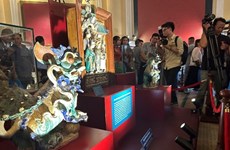New insights into Thang Long Citadel detected
The archaeological excavation of the ancient Imperial Citadel of Thang
Long, which was recognised as the World Cultural Heritage by UNESCO in
2010, has revealed evidence dating from the 11th century to 19th
century.
The archaeological excavation of the ancient Imperial Citadel of Thang
Long, which was recognised as the World Cultural Heritage by UNESCO in
2010, has revealed evidence dating from the 11th century to 19th
century.
The results were announced by the Archaeology Institute in coordination with the conservation centre of Thang Long Heritage on December 11.
Excavation of two holes covering over 100 square metres between February and December this year has uncovered cultural layers filled with architectural relics from the Ly, Tran, Le to Nguyen dynasties.
It is the first time archaeologists have found the foundation buttresses from the Ly and Tran dynasties at the location of Kinh Thien Palace.
Most notable, a huge drain from the Tran dynasty was found in the excavation.
Expert said the rich results from four digs in the Thang Long Imperial Citadel since 2011 have gradually revealed the main space of Kinh Thien Palace under the Le dynasty.
However, inferences on the central axis of the site from the Ly and Tran periods need further research.
A general and long term plan is necessary, but not just the exploratory excavation as what is being done now, they noted.-VNA
The results were announced by the Archaeology Institute in coordination with the conservation centre of Thang Long Heritage on December 11.
Excavation of two holes covering over 100 square metres between February and December this year has uncovered cultural layers filled with architectural relics from the Ly, Tran, Le to Nguyen dynasties.
It is the first time archaeologists have found the foundation buttresses from the Ly and Tran dynasties at the location of Kinh Thien Palace.
Most notable, a huge drain from the Tran dynasty was found in the excavation.
Expert said the rich results from four digs in the Thang Long Imperial Citadel since 2011 have gradually revealed the main space of Kinh Thien Palace under the Le dynasty.
However, inferences on the central axis of the site from the Ly and Tran periods need further research.
A general and long term plan is necessary, but not just the exploratory excavation as what is being done now, they noted.-VNA













